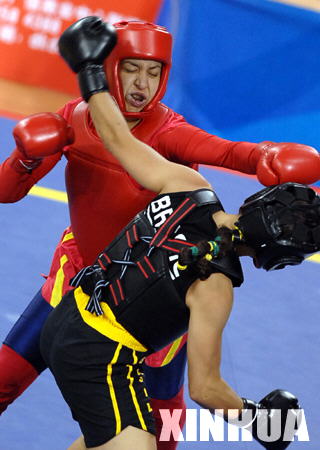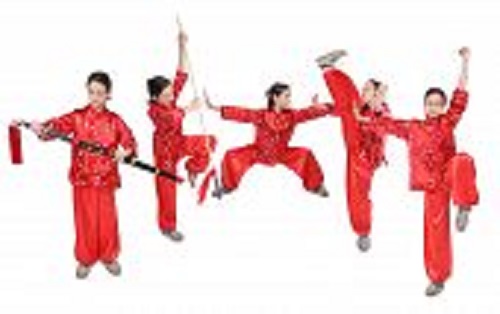Wushu: India
(→2019) |
(→Wushu) |
||
| Line 69: | Line 69: | ||
| + | =Junior Wushu World Championship | ||
| + | ==2022== | ||
| + | India win 8 medals in junior wushu world championship: The Indian contingent finished with a record eight medals, including three gold, in the 8th Junior Wushu World Championship in Tangerang, Indonesia. Besides the three yellow metals, India won as many silver and two bronze medals in the tournament that concluded.
AGENCIES | ||
| + | |||
| + | [[Category:India|WWUSHU: INDIAWUSHU: INDIA | ||
| + | WUSHU: INDIA]] | ||
| + | [[Category:Name|ALPHABETWUSHU: INDIAWUSHU: INDIA | ||
| + | WUSHU: INDIA]] | ||
| + | [[Category:Sports|WWUSHU: INDIAWUSHU: INDIA | ||
| + | WUSHU: INDIA]] | ||
=PART B= | =PART B= | ||
Revision as of 19:14, 18 December 2022
This is a collection of articles archived for the excellence of their content. Readers will be able to edit existing articles and post new articles directly |
Contents |
Wushu
Well, that depends on your vantage. Some might call it a martial sport in the modern world. However, a literal translation of the Chinese word indicates that "wu" means military and "shu" means art. In that sense, wushu is a term that describes the Chinese martial arts, similar to kung fu. In fact, both kung fu and wushu were once considered to be the same thing. However, these days wushu is more considered to be more of an exhibition and full contact sport. Here's why.
Wushu History
If one goes with the more literal translation of wushu as a term describing the Chinese martial arts, then the history is vast and somewhat clouded in mystery. Generally, the martial arts in China go back thousands of years and were formulated for the same reasons they were nearly everywhere- to aid in hunting and protect against enemies. One of the early formalizations of the arts seems to have occurred under Emperor Huangdi, who took the throne in 2698 B.C. Specifically, a type of wrestling was taught to troops at that time involving the use of horned helmets. This was called Horn Butting or Jiao Di. From there, the basics of Chinese martial arts history can be found in the following article (A History and Style Guide of Kung Fu).
These days, the term wushu is mostly used to describe an exhibition and combat sport, which is how it will be viewed for the rest of this article.
As was indicated earlier, the history of the Chinese martial arts are somewhat clouded in mystery. This is in part due to the length of time we're talking here- no history is very specific after thousands of years have gone by. However, it is also in part due to efforts made under Mao Zedong and Communist rule to destroy almost everything traditional in China. Literature at the Shaolin Temple was destroyed at this time, and kung fu masters fled the country, all of which left the native arts somewhat fractured.
Given this and more, in the mid 1900's the Chinese government attempted to nationalize and standardize the practice of martial arts in China. In essence, this turned aspects of it into a sport. In 1958, the All-China Wushu Association came to be via an appointment from the government. Along with this, the sport became known as wushu.
Along the way, the Chinese State Commission for Physical Culture and Sports compelled and moved forward the creation of standardized forms for most of the major Chinese arts, which led to a national wushu system with standards for forms, teaching, and instructor grading. Around the same time, wushu teachings were blended into curriculums at the high school and university level.
In 1986, the Chinese National Research Institute of Wushu was established as the central authority for the research and administration of Wushu activities in the People's Republic of China.
Wushu Competitions
Wushu competitions are generally divided into two disciplines- taolu (forms) and sanda (sparring). Taolu or forms are preordained movements designed to defend against imaginary attackers. The forms part of wushu competitions are of course judged according to specific criteria. However, in essence the forms that are used are derived in many ways from the traditional Chinese martial arts. More recently, wushu competitions have become known for highly flying acrobatics (high level spinning and jumping kicks, etc), than perhaps previously.
The sparring side of competitions- sanda, which is sometimes called sanshou- is all about standing or striking combat. That said, there is a level of grappling used in these competitions, derived from Shuai Jiao and/or Chin Na.
Generally speaking, there are main events in wushu competitions which are compulsory, as well as more individualized/other events. The compulsory events are:
Barehanded
Changquan (Long Fist) Nanquan (Southern Fist)
Taijiquan (or Tai chi chuan) (Taiji Fist)
Short Weapons
Dao (knife)
Jian (double-edged sword)
Nandao (Southern single-edged sword)
Taijijian (Taiji double-edged sword)
Long Weapons
Gun (Staff)
Qiang (Spear)
Nangun (Southern cudgel)
=Junior Wushu World Championship
2022
India win 8 medals in junior wushu world championship: The Indian contingent finished with a record eight medals, including three gold, in the 8th Junior Wushu World Championship in Tangerang, Indonesia. Besides the three yellow metals, India won as many silver and two bronze medals in the tournament that concluded. AGENCIES
PART B
YEAR-WISE RESULTS
2017
Pooja Kadian: world champion in women's 75kg
Pooja Kadian became the first Indian to be crowned world champion in wushu in the women's 75kg sanda event.
2019
Praveen wins historic wushu gold
Pratyush Raj, Oct 24, 2019: The Times of India
When Praveen Kumar took the flight to Shanghai to participate in the 15th World Wushu Championship, he was a bit overwhelmed. It was his first world championship and he had little idea about how difficult the road to the podium would be.
Praveen surprised himself as he scripted history to become the first Indian man to win a gold medal on Wednesday. He defeated Russel Diaz of the Philippines in the 48kg category, seeing off his Filipino opponent 2-1 in the men's sanda event, a mixed martial full contact sport. In the semifinals, Praveen had defeated Uzbekistan's Khasan Ikromov 2-0.
In 2017, Pooja Kadian had become the first Indian to be crowned world champion in wushu in the women's 75kg sanda event.
“It is surreal. I can’t describe it in words. The best feeling was to hear our national anthem during the medal ceremony. Nothing can beat it,” Kumar told TOI from Shanghai.
India finished third overall in the championship in sanda with a gold, two silver and a bronze. Poonam (women's 75kg) and Sanathoi Devi (women's 52kg) secured silver medals, while Vikrant Baliyan bagged the bronze in the men’s 60kg category. It was the fourth consecutive silver for Manipur’s Santathoi Devi at the worlds.
Praveen, who hails from Kalanaur village in Haryana’s Rohtak district, had no clue that he had created history at the end of his bout. “I was drained out after the match. I was completely blank and had no clue that I had become the first Indian man to win a gold. I got to know only after the bout when our chief coach (Kuldeep Handu) told me,” said Kumar, who is a jawan in the India Army.
Praveen started playing wushu in 2014 and won the senior nationals held in Patna the next year. Commenting on India’s performance, Handu said: “It is a massive achievement for us. Hopefully, we will be able to build on it. We have got great support from government under the Khelo India scheme.”

